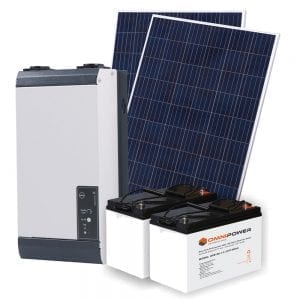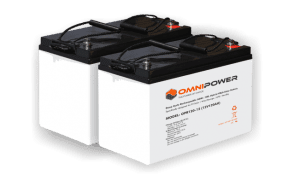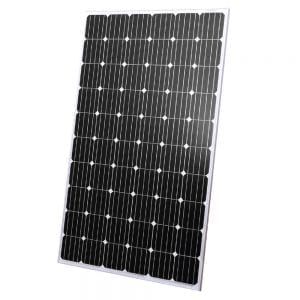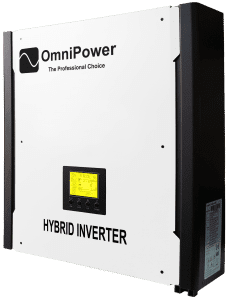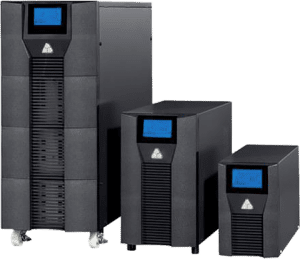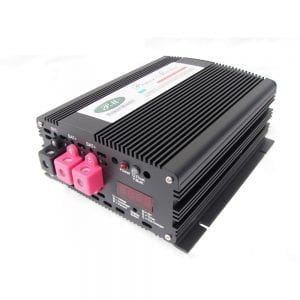The perfect photovoltaic (PV) solar system is one that meets your energy usage needs but also matches your budget, location, and environmental goals. Whether you need a solar power backup system for a home or business, all of these factors are unique, so we’re here to help you demystify the options and help you choose what’s right for you. By taking into consideration a range of factors with the help of experts, you can make an informed decision and install the PV solar system that ticks all the boxes.
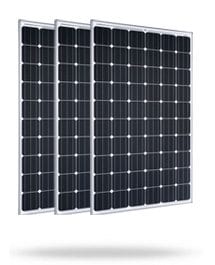
PV modules produce direct current (DC) from sunlight

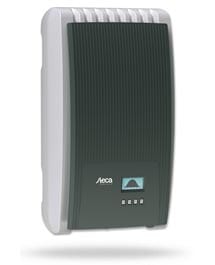
Inverters convert the direct current into usable grid-suitable alternating current (AC) and monitor the system.

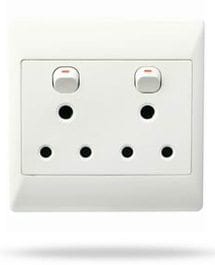
You benefit from inexpensive electricity, which makes you more independent.
What is a PV Solar System?
A photovoltaic system is a renewable energy system that converts solar energy from sunlight into electricity without producing emissions. PV solar systems consist of these components:
- Solar panels (usually made from crystalline silicon)
- A solar panel combiner
- A solar regulator
- An inverter
- A storage battery bank (if the system is not a grid tie system)
In a PV solar system, energy from sunlight is collected by a set of solar panels called a solar array in the form of direct current (DC). The collective energy of the panels is combined and then converted from DC into useable, grid-suitable alternating current (AC) by an inverter. Excess DC energy can be stored in batteries to be used when the grid is not available at night. The result is reliable, renewable energy that is inexpensive and empowers you to be more independent.
Different Types of PV Solar Systems
Solar photovoltaic systems can be used for electricity generation in residential, commercial, and industrial applications and, depending on their specifications and configurations can operate entirely off-grid, grid-tied, or hybrid.
A significant factor to consider when thinking about PV solar system installation is how much independence you want from the grid and how much equipment you’ll need to power. There are multiple options available each with its own benefits, including a completely off-grid solar system, a grid-tied PV system, or a hybrid system of the two.
Battery Backup Power System
A battery backup system is the key to an uninterrupted power supply even during power outages and loadshedding. A battery backup power system is not a solar system. It has no panels to generate solar power but rather consists of a bank of batteries plus an inverter charger that is wired into your DB board for seamless switching.
As long as the main supply is stable, your building draws its load from the grid as usual, while the inverter sends mains power to the batteries, ensuring they remain fully charged in the event of a blackout. When a power failure occurs, the backup system automatically switches to battery power within 15 milliseconds. When utility power returns, the whole procedure is reversed and the unit will automatically switch back to the grid and start re-charging the batteries.
Off-Grid PV Solar System
Off-grid PV solar systems are for ultimate power independence for residential, commercial and industrial needs. For situations where mains power is not available, or one wishes to become completely independent of the grid, an off-grid or stand-alone solar system is ideal.
In an off-grid PV solar system, all power is generated by the solar panels and a battery bank stores excess energy for use at night or when the weather is overcast. Because the system is your only source of power, many off-grid systems contain multiple charging sources such as solar, wind and generator. Having multiple sources of energy to charge the batteries maintains redundancy, ensuring a reliable off-grid system. This means that those with an off-gird PV solar system are never in the dark.
Off-grid solar system cost is something to remember when selecting the best PV solar system for you. Because they tend to be larger systems, requiring more solar panels and more battery storage, off-grid PV solar systems tend to be the most expensive solar system available.
Grid-tie PV Solar System
A grid-connected or grid-tied system is a solar electricity system without a power storage facility or battery bank. Grid-tie solar systems are dependent on the grid, and they can only operate when the grid is functional.
These systems are very popular in residential and commercial settings, especially in European countries, where they can feed excess power back into the electricity grid. While this is not a possibility in South Africa just yet, it may be a reality soon.
In a grid-tie PV solar system, your electric system is hooked up to both the national grid and your PV solar system, so you will always have electricity available during the day at the flick of a switch and you will have power at night provided the grid is stable. Solar panels or photovoltaic cells provide power during the day, and at night power is drawn from the mains. You can install a grid-tie solar system of any size, depending on your needs, and you will only ever be billed if your power consumption is in excess of the amount you are generating.
Because grid-tie systems are the ideal solar solution for day-time power supply, they are a good fit for commercial use in small to medium businesses that won’t need power at night when employees have gone home. Grid-tie systems also tend to have lower costs than other solar setups because grid-tie inverters are more affordable and these systems have no battery costs.
Hybrid PV Solar and Backup Power System
Hybrid PV solar systems are similar to a grid-tie system but with the added benefit of battery storage. Having batteries means that circuits with this system will have power no matter the instability of the grid, making hybrid solar systems South Africa’s most popular choice.
Another benefit of hybrid PV systems is the fact that they can be installed to ensure constant power to essential loads while keeping non-essential loads powered by the grid or by excess solar.
Hybrid solar systems are the best of all worlds, encompassing solar power with battery backup and returning all excess power generated by the solar panels to the grid and for this reason they are commonly used in both residential and commercial settings.
Incorporating a smart inverter into a hybrid backup power system takes power independence to another level. Smart inverters with peak shaving capabilities can be programmed to discharge the batteries during municipality peak tariff times, and charge them during offpeak times. This process is known as peak shaving.
Factors To Consider When Choosing The Right PV Solar System For You
Solar systems can be installed and used as an energy source in residential, commercial, and even industrial settings. Each of these has its own power requirements which necessitate various components and solar system configurations. Even within residential, commercial, or industrial environments, your energy needs will be unique, so it’s essential to start with your individual electrical needs when searching for the right solar system. Having a solar PV system working for you can be a game changer, but it’s vital that it matches exactly what you need.
While the right solar system for you depends primarily on your energy needs, there are other factors to consider as well. Budget, maintenance, and future modular expansion are all things to think about when choosing a solar PV system in South Africa.
Before you choose which system to install, you will need to take the following factors into account.
Amount of solar panels
Different solar systems have different energy outputs and that comes down to the panels in the system. The amount of solar panels your system has determines the load it can support. For example, if you have very high energy needs, or if you want an off-grid solar system, you will need more photovoltaic modules, but if you opt for a hybrid system you just need enough panels to supply your essential load and to charge the battery bank.
Other than your energy needs, the number of solar panels in your system may also be affected by the available space on your roof, house or business grounds, as well as the roof structure itself.
Questions to ask your installer include:
- How many panels do we need to cover our energy needs?
- How many panels can we fit on the property?
- How many panels can my roof carry without compromising its structural integrity?
System size
Determine the size of your solar system based on your energy needs and budget. A professional installer can help with this calculation. In South Africa especially, it’s important to install a solar PV system with the right kilowatt-hours (kWh) for your electrical load while also remaining within your budget.
When it comes to system size, most homes use 20kWh per day on average, while businesses will use 40-70kWh per day. If you want a PV system that offsets your grid consumption, you won’t need as big a system as you would if you wanted a completely off-grid PV solar system.
Certain factors will affect your power output and may influence the size of the system you choose. Latitude and climate, for example, are aspects you cannot change but that will limit your system’s output. You can maximise your solar output by having a professional PV installer find the ideal orientation and inclination of your solar panels for optimal energy uptake. This can help you get the most out of a smaller system and save some of your budget.
Energy storage
When choosing a solar system, decide if you want to incorporate energy storage solutions like batteries. Energy storage is an integral part of both off-grid and hybrid PV solar systems. Batteries can store excess energy for use during cloudy days or at night.
There are four main types of batteries for solar: lithium-ion, lead-acid, nickel-cadmium, and flow batteries. The type of battery you choose can impact your system’s capacity and longevity.
So what is the best battery for solar power? Lithium-ion batteries are the best choice for residential or small commercial applications because they boast a high energy density (they can store more energy while taking up less space), optimal efficiency, and a longer lifespan.
Supercapacitor batteries are manufactured with graphene, which means they are not chemical-based. This comes with superior benefits including non-degrading high cycle range and depth of discharge. For these reasons, supercapacitors are ideal for commercial, industrial, and utility uses.
While lithium-ion batteries and supercapacitors are more expensive than other alternatives, these benefits make them ideal for most solar installations and they can save you on battery replacement costs in the future due to their high efficiency and long lifespan.
Type of grid connection
Grid connection is central to the type of system you choose to run your home or business. After evaluating your power usage and your load needs, decide on the type of grid connection best for you.
Off-grid solar systems are ideal for those who want total energy independence, but it is the most costly option. Grid-tied PV systems are good if you are only concerned with savings on electricity costs from grid usage. Hybrid PV solar systems are the compromise between these two options; they are more affordable than totally off-grid systems, but more practical than grid-tie systems because they boast batteries that can supply power at night or on overcast days, even when the grid is unstable.
Determine whether you want to remain connected to the grid, go off-grid, or use a hybrid system. Your choice will affect the size and design of the solar system.
Budget
Probably the biggest deciding factor when choosing the right solar system, other than your energy needs, is your budget. Make sure that you choose the right system that suits your budget, but don’t compromise on your needs.
Sinetech’s rent-to-own solar systems are designed to meet your home or business’s unique electricity needs in the most affordable way so that your budget doesn’t hold you back from grid independence and uninterrupted power supply.
Future expansion
Consider if you may want to expand your solar system in the future to accommodate increased energy needs. You may want to install a hybrid PV solar system in a modular form and expand in the future to become completely off-grid for example. Or you simply may want to increase your electrical output with time as your family or business grows. When deciding on your solar system, consider what features or photovoltaic technology you want that may change over time and plan accordingly.
Ways to expand your PV solar system include:
- Adding solar panels to your existing system. This will increase the amount of energy your system can generate but you will need additional roof space for this.
- Replacing your solar inverter with a larger, more efficient one or increasing the number of inverters. A larger inverter or multiple inverters can increase your daily energy yield and ensure you get the most from your solar system.
- Retrofitting more batteries. This increases the amount of energy your system can store for use on cloudy days or at night. This method requires additional space to mount new batteries, but not much.
Whether you plan to increase your power generation, inverter efficiency, or energy storage, planning ahead when you first install your solar system is important. Ensure your installer is aware of your future goals and builds and mounts your system components to accommodate for future expansion.
Maintenance
Another aspect to consider when choosing the right solar system for you is the amount of maintenance the system will need. From cleaning the solar panels to dusting the air vents of the inverter, all components of a PV solar system need periodic maintenance if you want to ensure optimal efficiency and a long lifespan.
Solar panels are generally low-maintenance, but inverters and batteries may need periodic attention. Larger systems will need more maintenance. When choosing a solar system, ask yourself if you will have the capacity to bring in a specialist periodically to keep things running smoothly.
It’s also important to look for a solar system supplier or installer that offers a warranty and to ensure you maintain your system well to keep the warranty in effect.
Frequently asked questions
Deep cycle batteries are the best batteries for a solar power system because they have a long lifespan. AGM batteries and lithium-ion batteries are the ideal deep-cycle batteries for solar use because they have a greater energy density than other battery types and impressive longevity. The Omnipower OPS and the Hoppecke OPzs solar series available from Sinetech are both premium-quality deep-cycle batteries that enable solar systems to function optimally.
The size of the system you need depends on your existing electricity usage. A solar system that meets your needs will need to produce enough PV power to cover your electrical load. To find out what size solar system you need, find out your average monthly usage in kW and divide that by 30 days. Then divide the answer by 5.5, which is the average hours of peak sun in South Africa. This will tell you how big your solar panel array needs to be, however, an energy audit is more accurate at sizing your solar system.
A PV solar system in South Africa can cost anywhere from R60 000 to R250 000 depending on the size of the system. An average 5kWh PV system, which is ideal for most residential systems, costs approximately R100 000. Fortunately, the cost of solar systems has decreased over time and will continue to do so, making going off-grid much more affordable.
PV stands for photovoltaic. PV technologies convert sunlight into usable electrical energy for home, commercial, and industrial use. The solar panels or PV cells in the PV array collect energy from the sun in the form of direct current (DC) and then channel it to the inverter, which converts the electricity into alternating current (AC). This energy can then power homes or businesses, or be stored in batteries as DC for use at night.

